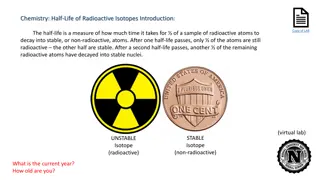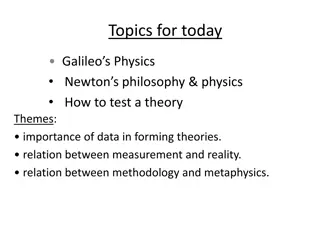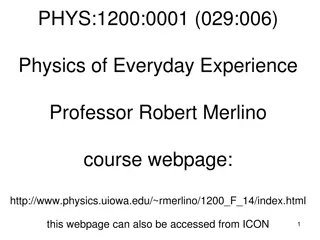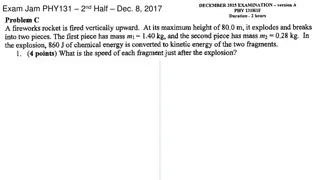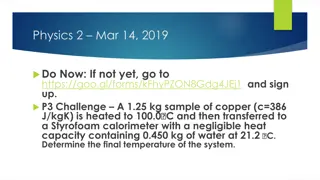Understanding Half-Life in Physics
Half-life is a key concept in physics, particularly in radioactive decay. It is the time taken for the activity of a radioactive source to decrease to half of its original value. This can be determined experimentally through measuring counts per minute and graphing the data. Additionally, half-life can be calculated numerically using initial and final activity values. Examples provided illustrate how to calculate half-life and determine original activity levels based on known parameters. Understanding half-life is essential for various applications in science and technology.
Download Presentation

Please find below an Image/Link to download the presentation.
The content on the website is provided AS IS for your information and personal use only. It may not be sold, licensed, or shared on other websites without obtaining consent from the author. Download presentation by click this link. If you encounter any issues during the download, it is possible that the publisher has removed the file from their server.
E N D
Presentation Transcript
S3/S4 Physics Half Life
Half Life Half Life The half life of a radioactive source is the time taken for the activity of the source to fall to half its original value Half life can be found experimentally by using the following apparatus.
Half Life Half Life
Half Life Half Life Before the gas cell containing the radioactive source was placed in front of the GM tube the background radiation was checked. The counts per minute(cpm) were then recorded every 30minutes. Results Time (minutes) 0 30 60 90 120 150 180 210 240 Corrected Count Rate 184 152 123 98 81 67 57 50 44 A graph can be plotted and the half life can then be found.
Half Life On your graph find the time that matches to a corrected count rate of 160cpm. On your graph find the time that matches to a corrected count rate of half of 160 i.e. 80cpm. The gap between the two times is the half life. You can check this for other pairs e.g. 130 and 65 or 100 and 50. There may be slight differences. If this is the case you would find an average value for the half life based on all your pairs.
Half Life Half Life It is also possible to calculate half life using a numerical approach. Example One A sample has an initial activity of 256Bq. One day later the activity is measured as 16Bq. Calculate the half life of the sample. Solution When 256Bq is halved it becomes 128Bq When 128Bq is halved it becomes 64Bq When 64Bq is halved it becomes 32Bq When 32Bq is halved it becomes 16Bq In other words, you need to half 256Bq four times to in one day to get to 16Bq. In hours each half will last for 24 / 4 = 6 hours.
Half Life Example Two A radioactive material has a half life of 50years. The present day activity is 45Bq. The material is 350years old. Calculate its original activity. Solution To find the solution you need to count back in time in 50 year steps and at the same time double the Activity of the sample. This solution may be easier to present as a table.
Half Life Time Activity Present day 45 Bq 50 years ago 90 Bq 100 years ago 180 Bq 150 years ago 200 years ago 360 Bq 720 Bq 250 years ago 1440 Bq 300 years ago 350 years ago 2880 Bq 5760 Bq
Half Life Example Three A source has a half life of 5days. Its activity today is 96Bq. Calculate the source s activity 20 days from now. Solution To find the solution you need to count forward in time in 5 day steps and at the same time half the Activity of the sample. This solution may be easier to present as a table.
Half Life Time Activity Present day 96 Bq 5 days (forward from now) 48 Bq (half of 96) 10 days (forward from now) 24 Bq (half of 48) 15 days (forward from now) 12 Bq (half of 24) 20 days (forward from now) 6 Bq (half of 12)
Review Questions Q.1. The activity of a radioactive source is 3200 Bq. After 150 minutes the activity is found to be 100 Bq. Calculate the half life of the source. (Answer: 30 minutes) Q.2. A radioactive source has an activity of 640kBq. The half life of the source is 8 days. Calculate the activity of the source after 40 days. (Answer: 20 kBq) Q.3. Carbon dating uses a radioactive material which has a half life of 5730 years. The present day activity of an object is 70kBq. The material is 17190 years old. Calculate its original activity. (Answer: 560kBq)


